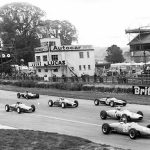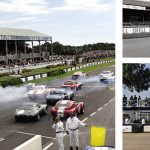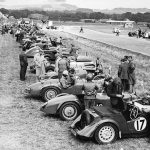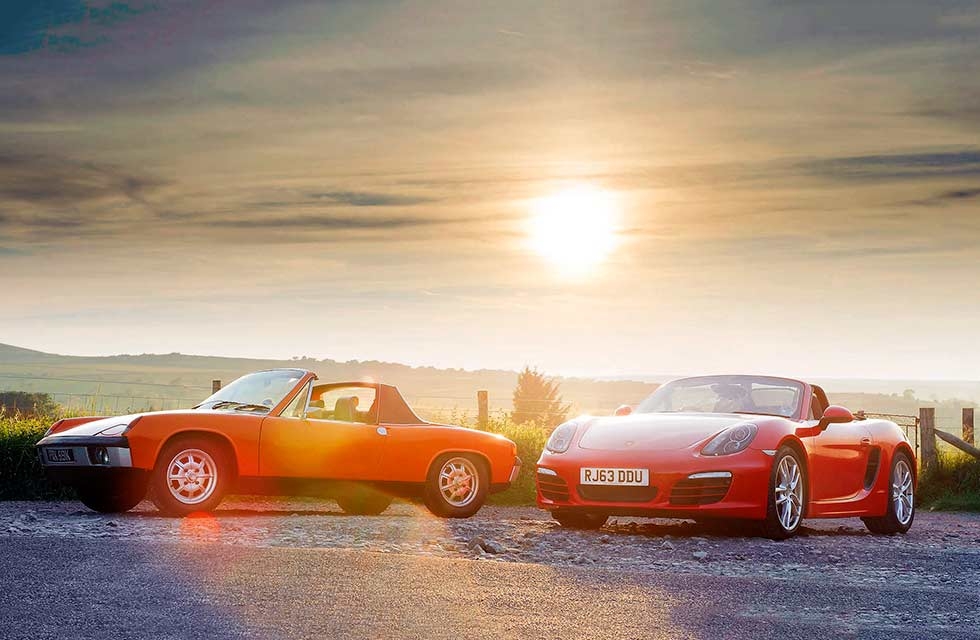
914 1.7 & Boxster 2.7 981 Porsche’s commitment to mid-engined roadsters is commendable and reuniting an original 1.7-litre 914 with the latest 981 Boxster 2.7 highlighted just how good these Porsche’s are.
44 years separates the 914 from the 981 Boxster, but Porsche’s mid-engined sports cars still share the company’s common DNA. Story: Adam Towler. Photography: Stephan Hall.
Finishing What They Started
The term ‘entry-level Porsche’ is often said with an unspoken but pregnant sneer, frequently joined in an ugly green-eyed lexicon by the phrase ‘the Porsche for those who can’t afford a 911’. I have never been able to understand why some feel aghast that Porsche should make a more financially accessible car. Cars should be assessed on their own merits, surely?
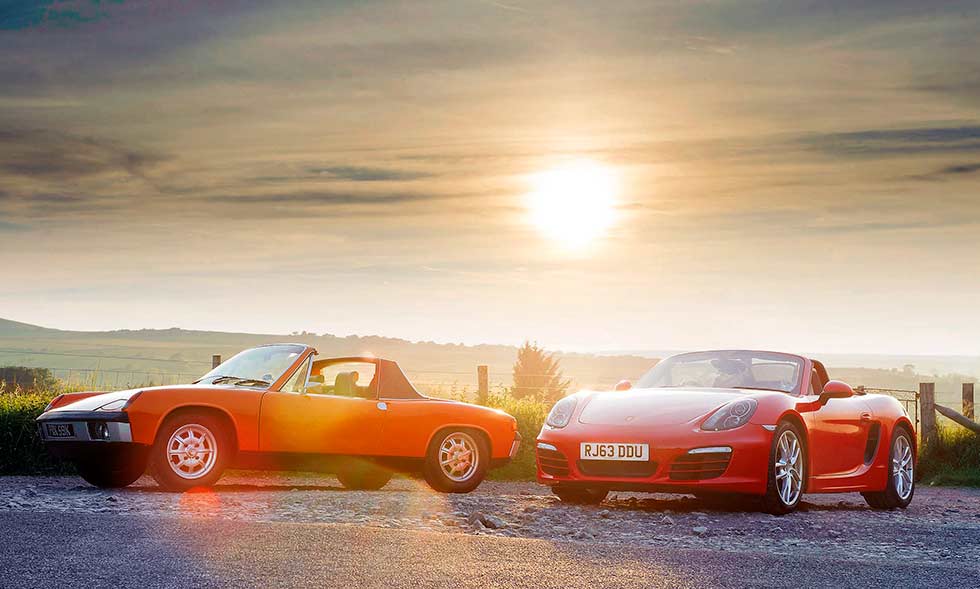
Today, with the development of a disparate range of cars within the Porsche family, such as the Macan, Cayenne and Panamera, the 911-and then-everything-else mentality is fading away. So I use those same words ‘entry-level Porsche’ in the best possible spirit when we reflect on the two cars we have assembled here: during their respective lifetimes, they did, and do, mark the point where new Porsche sports car ownership begins. If you’re thinking this pairing are engaged in some kind of competitive face-off then one blip of the 914’s gravely four-cylinder engine makes any such comparison seem absurd: with just 80, rip-snorting horsepower, the 914 struggles to stay in the same county as the latest 2.7-litre Boxster let alone shadow it on a B-road. While this Mk3 Boxster may indeed be the range starting point it now musters a sturdy 265hp from its direct-injection flat-six, an engine so infectiously sweet in nature it feels happy to withstand hanging off the rev limiter for hour after hour at a time. Zero to sixty is dispatched in as little as 5.5 seconds: the 914 clocks in around 11-13 seconds for the same sprint, depending on source. You get the picture.

It’s hard to think of the Boxster as a small, accessible sports car alongside the 914. The older car looks like a toy next to Porsche’s latest roadster, a phenomenon created not just through age and the widespread growth in car dimensions, but because the latest Boxster has morphed into a grown-up sports car – in size and performance terms – with this latest incarnation. Genuine road presence is something that the ubiquitous Boxster hasn’t always been able to boast of, 987 Spyder excluded.
The 914 is also something of an unknown quantity on these shores. As such there’s the indefinably mystical air of a cult car about its unusual, crisp form; few know what it is, or who made it. Then again, when you consider that over 100,000 of the 118,976 made went to the USA, and that there were officially just 100 (left-hand drive only) cars imported into the UK, that’s hardly surprising.
This sports car project was born into the cosy working relationship that has often existed between Volkswagen and Porsche, based on history, expediency and consulting work, and even literally by marriage – VW boss Heinz Nordoff’s youngest daughter Elizabeth married the eldest son of Anton and Louise Piech. In essence the plan was to build a simple VW sports car to replace the Type 3 Karmann Ghia, with a Porsche-powered six-cylinder version that represented Stuttgart interests to be sold alongside it. The car would be designed and developed by Porsche, naturally: Ferry Porsche was keen to broaden the firm’s product range given the escalation in 911 prices at the time.
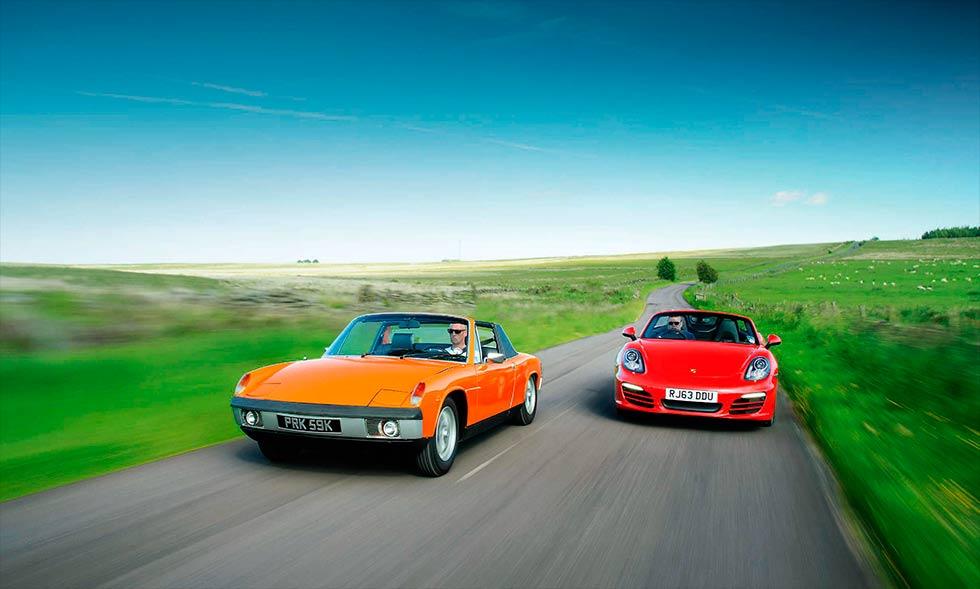
At first everything progressed relatively smoothly, and the mid-engined layout was right at the cutting edge of automotive design in the late 1960s. As the car had to be sold as both a VW and a Porsche, the design of the body couldn’t really follow any previous marque styling themes, and the result, initiated by a product design firm and then carried on by Butzi Porsche in-house, was startlingly different and aimed squarely at the forthcoming decade, not the present. Powering this new sports car was an all-new air-cooled flat-four destined for VW’s imminent 411 saloon. At 1679cc this pushrod unit, using Bosch electronic fuel injection, mustered 80hp at a decidedly low peak of 4900rpm and 98lb ft at 2700rpm, with drive taken through a repackaged version of the five-speed gearbox in the contemporary 911, complete with a dog-leg first gear layout.
So far, so good, but the 914 project was about to hit stormy seas. After a period of ill health Nordoff passed away in 1968, and his successor at VW – Kurt Lotz – was an altogether different type of manager. Gone was the amiable relationship between Heinz and Ferry, and in the contract between the two firms all it said in black and white was that Porsche would design and develop a sports car for VW. There was no mention of Porsche slotting in a six-pot motor and selling it as a Porsche, and it was the first Lotz had heard of such a plan…
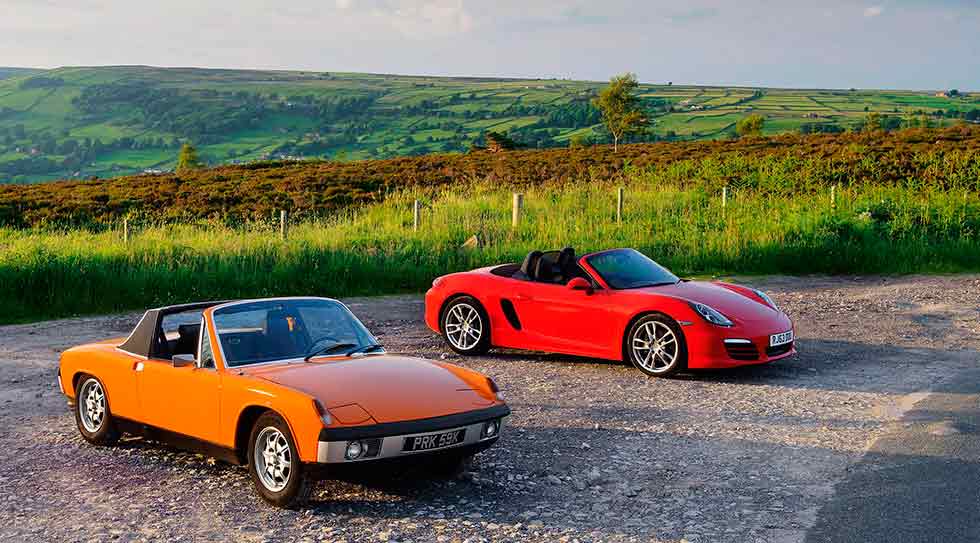
After negotiations the issue was resolved, but the ramifications of these decisions would contribute greatly to the 914’s troubled career. Porsche and VW set up a new company to sell the car in Europe: the VW-Porsche Vetriebsgesellschaft GmbH (VG), which had its headquarters just outside Stuttgart. In the USA, another new company was formed to sell not only all Porsches (inc the 914) but also to introduce the Audi marque to America, this firm being known as Porsche+Audi, the logo of which always makes me think of those outrageous CanAm 917s during the early 1970s.
All 914s were built by Karmann at Osnabruck: the 914 completely so, the 914/6 in terms of body and interior, but the ‘Porsche’ was then shipped to Zuffenhausen where the engine was installed and the car finished like any other 911. The key issue was how VW had done its sums over pricing the bodies to Porsche, which left the figure very high and immediately set the 914/6 at a tremendous disadvantage. As such, the car was nearly as expensive as a 911 2.2 T, compounding general 914 issues such as market acceptance of the watered down VW-Porsche image, and making it look very pricey for a car that still only mustered 110hp. In motorsport, the Group 4 914/6 GT had a mixed career, a high point being the remarkable sixth overall at Le Mans in 1970, and the proposed 916 (a road car version of the 914/6 GT with a solid coupé roof) was cancelled a fortnight before its debut. The exotic 916 was considerably more expensive than a 911 2.4 S – in some ways a forerunner to the Carrera GT – but Porsche got cold feet when doing the sums, a legacy of that VW invoicing and rising exchange rates.
History round-up completed for now, it’s back to our little 1972 914 1.7. New owner Gary is collecting this example from Gmund Cars on the day of our photoshoot, and then off on a formidable road trip to his home in northern Italy. This rare UK car – Andrew Mearns of Gmund estimates there may only be ten UK cars left – lived in Scotland for many years, sharing barn space with various tractors. Although the last tax disc expired in 1981, it was in excellent condition body-wise, requiring only a repaint (to solve paint fade) and a general recommission to get it on the road for Gary. As Andrew says: “We’re bringing a lot (of 914s) into the UK now. I’ve always been a huge fan of the 914; it’s a well-engineered and well-balanced car. As the market moves we have to move with it, and these cars give the owner a lot of fun for not a great deal of money. We’re getting lots of calls on them.”
With the Yorkshire sun beating down on our backs and not a hint of the gruesome wintery weather that has affected many-a moors photoshoot, it’s not surprising that the 914’s broad Targa roof panel is stored away from the start. In many ways the 914 is a curious shape, but for many – me included – that only adds to its appeal. Pencil-thin front wings are devoid of the main lighting requirement, these being of the ‘pop-up’ variety cited in the main expanse of front bonnet. The glasshouse is almost oversized – predictably vision from inside is excellent, particularly so for a mid-engined car of the period – but the odd ‘basket handle’ B pillar gives the car a deliberately truncated roofline. Its flat, broad body surfaces are wilfully minimalist. It is unashamedly modern – a car that embraced the future with a happy heart, rather than one that looked back at traditional chrome and stringback driving gloves for inspiration. As owner Gary also opines, it’s a classless car that’s comfortable anywhere.
Inside, the same philosophy pervades. There are two, almost hammock-like seats, positioned in a cabin devoid of the typically high transmission tunnel associated with many mid-engined cars. The resulting flat floor exaggerates the feeling of width and space, as does the thin and rather sparse dashboard. A wand-like gear lever sprouts from the floor in the period Porsche style and there’s an unfamiliar badge on the steering wheel boss – that of the VW-Porsche VG, not a brand I feel an initial great warmth to if I’m honest – but otherwise there’s not a great deal to look at. Better turn the key, then.
The motor churns into life with little sense of romance, but not for the first time today one’s general mood depends on expectation. Come to the 914 with a mind full of howling flat-sixes and you’ll be disappointed, but be realistic – and the 5600rpm war paint on the tacho is another nudge in this direction – and you’ll focus instead on other aspects of the car.
The first challenge in the 914 is the gearbox. In fact, mastery of this mechanism is the key to swift – okay, let’s not get ahead of ourselves here – progress. As mentioned, first is out and back towards the driver on a dogleg, but it’s a long way across. One you’ve got an appreciation of where second is things start to make more sense, because the other gears are easier to mentally picture. Nevertheless, it’s hardly a Ferrari open gate sort of gearshift, and Motor Magazine in its test of the time described it as “horrible”. I don’t find this too bad once my experience of it accumulates, but it’s clear that it dictates a lot of the 914 driving proposition at this stage of the relationship between car and driver.
Then there’s the motor. It is an engine to do a job, but in this state of tune, there’s not a lot more you can say about it. Although it doesn’t rev out with any great exuberance you do need to work it hard if you’re to make progress, at which point it emits a typical flat-four cacophony. But it’s soon apparent that the 914 has other attractions worth focusing on. It’s a car that majors on delicacy of inputs and precision – the sort of car you drive with a light touch, conserving momentum and not going in search of unobtainable power oversteer. Driven thus I soon find myself enjoying the 914 a very great deal: the thick-set roll bar and snug cabin give a feeling of being protected from the elements, but even so it feels like an authentic open-top sports car experience. The 914 is flowing along nicely, the flat-four growling away just over my shoulder and the gearbox doing its best to throw an occasional curve ball at my still hesitant right hand. The brakes have a good feel to the pedal, but it’s the steering and overall sense of balance that make the biggest impression: the latter is hardly surprising when we later pop the narrow engine lid that nestles right behind the passenger compartment. The engine block is clearly right up against the bulkhead, making for a decidedly mid-engined car, not a mid-rear engined car as many sports cars should more accurately be labelled.
After the simple enjoyment of the thrumming little 914, the new Boxster is a completely different experience. In fact, it may have well of just descended from a different planet. Its design is curvy but aggressive after the cerebral 914, and it’s a big car now, too – a long way removed from those first, almost dainty, 986 models. Sat inside, and with the seat dropped low, you feel perfectly cocooned even with the roof down – which has just dropped with merely a single press of a button – the high door sides and transmission tunnel placing you within a sturdy feeling structure. This is exacerbated once we’re on the move, as it’s obvious the torsional rigidity of the 981 is much higher than in any previous Boxster. Bumps and ridges in the road that make the 914 clank and buck are calmly dealt with as if the car has a fixed roof.
Compared with certain modern performance cars, particularly those with turbochargers, the 2.7-litre ‘six is an engine that needs to be revved right out if it’s to give its best. There’s not a great deal of torque at low revs, but with a gearbox as sweet as this – if only the 991’s manual ‘box was in the same league as this – that’s no great chore, in fact, it’s a real pleasure. In an age when highly strung naturally aspirated engines are thin on the ground, let alone in combination with a manual gearbox, the simple pleasures of working the Boxster’s engine up and down the rev range, supplemented with the occasion blip of the throttle between gearchanges, is a pastime to cherish.
So they don’t look alike, sound alike or even share quite the same badge, but there is a comparison to be made here and it’s in their driving character. Like the 914, the latest Boxster is not a car to thuggishly haul around; it likes precise steering inputs, via a rack that’s sadly lost a fair deal of its communication to the driver, but thankfully not its accuracy. You guide a Boxster into a fast curve and revel in getting the line just right, before making the most of what power you have available on the exit.
The 914 range was broadened with the advent of a 100hp 2.0-litre model for the 1973 model year, which also benefited from a shorter and more rigid gear linkage. It was, said some, the car the 914 should have been all along. That year Porsche got close to its original sales forecast of 30,000 units per annum, but the writing was on the wall with the disbandment of the VG when Porsche bought out VW’s share in 1974. The last few cars were sold in 1976, but VW – under new management once again – and Porsche were already cooperating on another new ‘entry-level’ sports car: the 924 was the future, now.
However, it wasn’t really until the advent of the Boxster in 1996 that the ‘entry-level’ Porsche really found its feet, enough that is to form a dynasty that survived beyond the first and now second model generation to establish a clear bloodline. What the 914 started, the Boxster has more than finished. As for Gary, he and ‘PRK’ made it home in style. Maybe the 914’s time has yet to come after all.
With thanks to 914 owner Gary and Gmund Cars (www.gmundcars.com 01423 797989) for their help with this feature.

